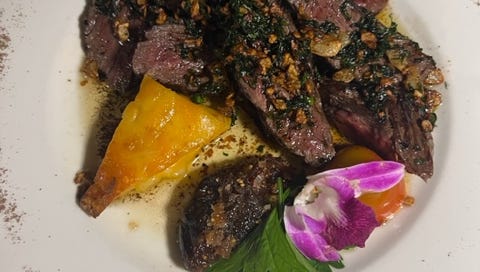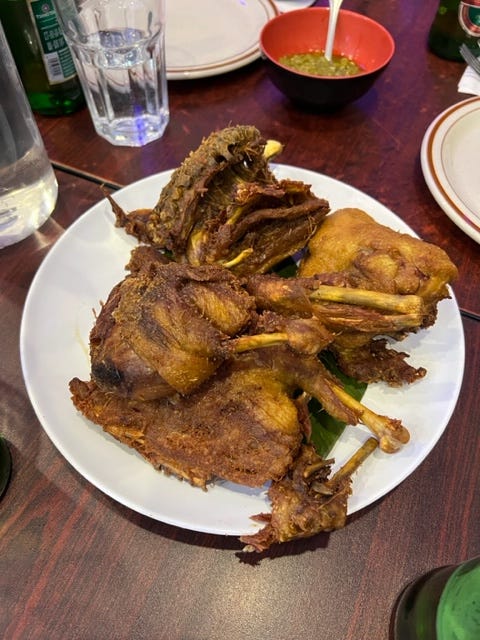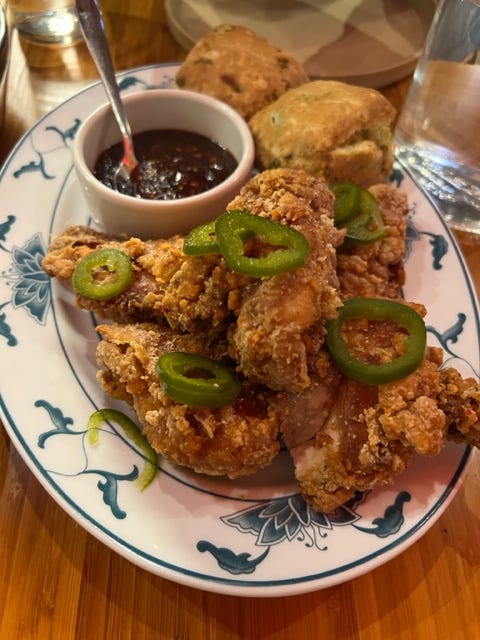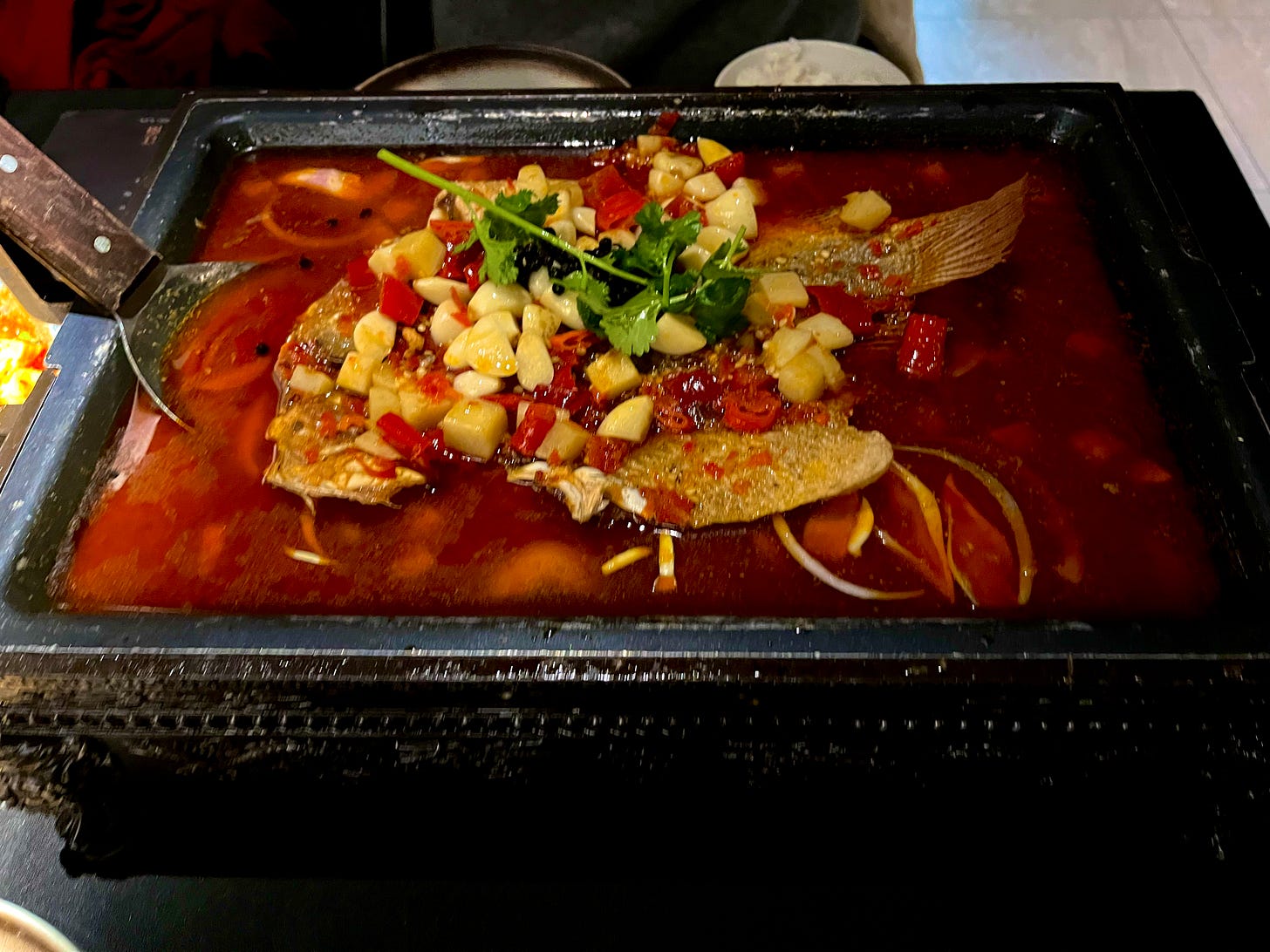I went to Rotterdam for the first time in January with culinary expectations that weren’t so much low as irrelevant. Everyone seems down on Dutch food; of Rotterdam specifically, a friend told me that “If the food is from a former Dutch colony, it’s probably good.” That worked well enough as a rule of thumb, as at the Malaysian place close to IFFR’s main theaters, which had a pretty tasty beef rendang, even if the people running it were actually Chinese (which explains why they were also serving the globally-on-trend jianbing).
I was, however, unexpectedly fascinated by kapsalon—less the dish itself than its preparation. Kapsalon is straight-up disco fries with regional variation in its particulars: doner or shawarma meat, gouda melted on top (the supermarket-slice looking kind, not the luxe-y sort), iceberg lettuce and a ranch-y dipping sauce on top or on the side. There isn’t much distinguishing this from anything labeled “Irish nachos” or a college student’s microwavable feast, and while there’s nothing wrong with this kind of debased poutine, that this not-so-inventive dish is a point of regional pride—and that its origins can be traced so precisely as to pin its invention to 2003—maybe underlines the oft-reiterated point of “Dutch food not being that good.”
I ordered it twice, the first time on my first night, with little time between screenings or inclination to wander around unfamiliar territory looking for better. A Surinamese place I’d heard about was slammed, so I wandered across the street to the Jaffa Shoarma Cafe; their Instagram says they’ve been open since 1979, presumably for years as a straight doner purveyor, but when I walked in, I was reminded by the menu board (and what everyone around me was eating) that kapsalon exists.
There were familiar cylindrical spits of rotating meat, but the novelty came from what happens after it’s shaved off. I watched a middle-aged Dutch man tend a dozen or so skillets under various broiler flames, and it eventually became clear that meat was being distributed into different pans, each individually tended under its own small fire, before being dumped on fries, with that plated mixture then having cheese added and the whole plate or to-go foil container then shoved back in to finish the melting process.
I’ve watched many people operate spits and finish the shaved meat off on a flat-top, and I can think of precisely zero reason why finishing the meat in a pan under a flame would do anything at all that a flat-top wouldn’t. It seems a needlessly ornate process, like a vaudeville hat-juggling act for short-order cooks. The more I thought about it, though, the more I liked it. I’m the champion of insisting that I have to go to precisely this one store to acquire this exact one ingredient that’s this much better than the same item bought elsewhere, and while I’m probably right most of the time, I’m also probably not that much more right for all my extra troubles, so I respect the impulse to do the over-the-top same for a different purpose. I ate the whole thing by myself outside, listening as four European dudes with wildly clashing accents pooled their funds, repeatedly called each other “bro” in thick/indeterminate brogues and argued about how much everyone had to pitch in for cigarettes.
La Sirène — Special Occasion Dinner #1 (one-on-one). After scanning numerous lists of “default fancy French places in NYC,” I settled on this one because a lot of the more fashionable ones, while doubtless culinarily delightful, all look designed for Instagram in a way that’s loud and sceney, which was not what’s desired. It was opened in 2007 by Didier Pawlicki, who said in 2010 that he was ceding control to chef Sebastien Agez (who, for what it’s worth, does not include any time there on his LinkedIn).
The Soho space is small and seemingly underpopulated; I had a reservation but certainly didn’t need it to be seated, though presumably the expense of an average dinner balances that underpopulated feeling out or they wouldn’t still be open. (The reason you need one, of course, is as a covert way of letting them to know it’s a birthday dinner so they can bring out a candle with dessert.) The menu still has Pawlicki’s voluble fingerprints all over it; opening pages explain why the only card he takes is American Express (other companies denied his credit applications when he arrived in the states), while subsequent ones contain eccentrically described dishes (“sensual little French ravioli”) that annotate not just their ingredients but their desirability or novelty (said ravioli are a “rare find”). Whoever’s in charge now, the food is obviously excellent; those sensual ravioli were basically a novelty, but the beef tartare was top-notch, the pork with mushroom sauce delightfully saucy and the hangar steak [“(signature, not found in NYC or else!),” above] excellent, in part because it came with a comical amount of roasted garlic.
Awang Kitchen — Special Occasion Dinner #2 (group variant). I first ate at this Indonesian restaurant in January 2022, during which I learned that the first word of the name wasn’t an untranslated noun or adjective but the chef’s name—he was taking a kitchen break with friends at the table next to us and introduced himself as we were getting done. The food was obviously great but there were only two of us, so my birthday was a good excuse to compel people to trek to a particularly subway-accessible-difficult corner of Elmhurst. It’s always a good idea to check the specials board, translate the whole thing and order half of your items from there, then the rest from the permanent menu. Because I am duck-obsessed, I especially enjoyed the bebek goreng (“fried duck with green chili on side,” above) as well as the kankung (water spinach) hot plate, meaning it arrives on a sizzling fajita platter, something for which I am always a sucker. The wall is covered with photos of happy Indonesian visitors to the restaurant, a freaky number of which are men with military titles. Probably best not to dwell on this too much.
Potluck Club — This place, which is among the “Manhattan Chinatown, but for beautiful people and priced accordingly” class of newcomers, is totally decent. The salt-and-pepper fried chicken (above) is as described, nicely cooked and flavorful if not exceptional (though the habanero jam does actually make it all come together). The scallion pancake biscuit it comes with is truly good, a successful experiment in rendering Pillsbury textures with actual finesse. The rice cakes are fine, and the optional add-on hangar steak that you can get for $8 is also fine. But—and I do hate to be the world’s most annoyingly cost-conscious Yelp reviewer—if I am going to make a reservation for same-day dining, and all I can get that night is at 9 PM and they’re 15 minutes late in seating anyway and the food (which, again, is totally fine) is priced at $26 for a chicken entree, what are we paying for again? Proximity to other people who look like they also work in media (or, alternately, not at all)? An admittedly very nicely designed wall full of fake digital monitor lobby cards for Stephen Chow movies? (I know the real answer: I can afford it, I’m willing to play along and I deserve everything I get accordingly.)
Jiang Nan — “Potluck Kitchen” is “fusion” in the Mission Chinese sense, i.e., reworking a variety of Chinese/Chinese-American dishes as a starting point for culinary mashups way outside Chinese food without worrying about “authenticity”; Jiang Nan, whose website explicitly takes “Chinese Fusion” as its slogan, means that differently, in the sense of offering pan-Chinese food that doesn’t worry about fidelity to the area of its origin. E.g., the Sichuan staple mapo tofu is here rendered with larger pieces of tofu than usual, which are definitely not the traditional silky kind, in a cornstarch-heavier-than-usual broth; I assume this is in line with pan-Chinese preferences. (I would say “Cantonese,” as that’s so often used to describe this less-spicy Sichuan cooking style, but I don’t actually know that that’s accurate.) It’s good! On every table there’s either a half Peking duck or a grilled fish; we got the latter (above) with Sichuan traditional flavor (one of 11 available, including “kimchi cheese sauce”—that fusion element again), and it was on-point. Jiang Nan is currently a mini-chain that began in Flushing, but they’re aggressively expanding, with five locations in the tristate, another three opening imminently—including one in Washington—and with plans for 40 [!] listed on their website. I’d be fine with that. (And I need to come back for the duck. Always duck.)
The Google Map to date.







